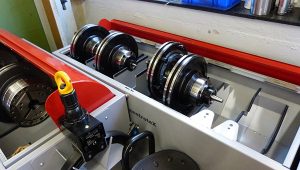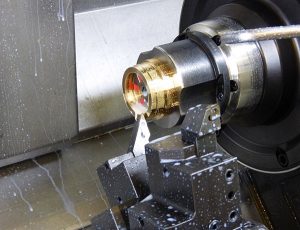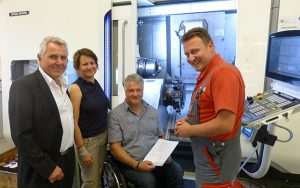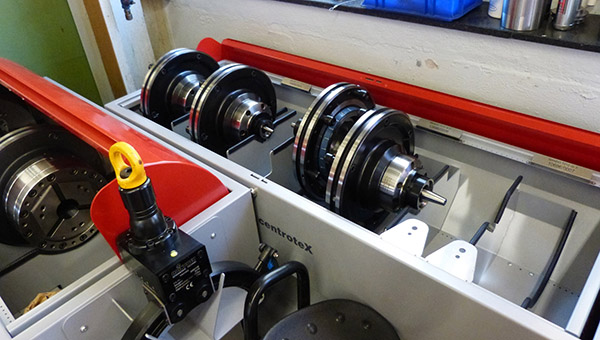Steinel Normalien AG, a specialist manufacturer of cylinders, guides, springs, plates and die sets for the tool-making, stamping and forming industries, imposes the most rigorous precision requirements upon its manufacturing department. When the company introduced a new mill-turn centre, this manufacturer of pneumatic spring and composite systems was intent on streamlining its work-holding processes, so the 150 employee company sought its solution from Hainbuch.

Steinel was aiming to significantly reduce its set-up and throughput times, but the company with 25,000 different stock items and catalogue products recognised that it was not as flexible as desired. The company exerted significant time and effort with changeovers from jaw chucks to other clamping devices, however, thanks to Hainbuch, these times are now gone for good.
The combination of a new mill-turn centre, new clamping devices from Hainbuch and new machining strategies have increased manufacturing flexibility significantly. Now, a wider variety of parts can be machined and many processes eliminated, while three previous machine tools have been replaced with just one. The two men responsible for the project, Michael Tresselt, head of process development and James Hepfer, shift supervisor, recognised that the machining concept needed a rethink.
“With the new turning concept we wanted to achieve higher flexibility and optimise the set-up procedure. In order to quickly change the clamping devices on the new mill-turn centre, quick change-over systems were required. We carefully examined several system suppliers and their clamping solutions.”
Thomas Helfer, a Hainbuch sales representative, made a routine visit to Steinel and both men were very satisfied with the clamping devices and clamping heads from Hainbuch, which were already in use at Steinel. This larger project required a significant investment, and both Tresselt and Hepfer were not 100% convinced by the solutions they had seen previously. Competition was narrowed down to two suppliers, as Tresselt reports: “We then prepared an evaluation matrix of the available quick change-over systems. After a more precise test, Hainbuch’s flexible and highly accurate clamping devices convinced us. In particular, Hainbuch scored high with its insensitivity to contamination and repeatability.”
Hepfer explains the difference between the two leading change-over systems: “With Hainbuch’s competitor, the system works with a pull action. In comparison, the Hainbuch system does require screw turning, but the clamping device is more accurate and rigid. There are only six screws and they only need to be loosened slightly, which is why the procedure takes almost no time. The competing product has problems with its contamination sensitivity. Even if tiny dust particles get in the system, accuracy and rigidity suffer. The Centrotex interface from Hainbuch completely convinced us.”

Tresselt adds: “For change-over accuracy, Hainbuch provides 2 µm precision, while the competition specifies 0.01 mm. This difference is of absolute importance as our workpieces have strict parameters that we must keep. Moreover, with Hainbuch we get everything from a single source. With the Centrotex quick change-over system on the main and sub-spindle, we use a hexagonal Toplus chuck size 100 and a size 260 jaw chuck. This makes us extremely flexible and everything is interchangeable.”
With Hainbuch, Villingen-Schwenningen-based Steinel has certainly adopted the right clamping devices and impeccable level of accuracy for the high-precision manufacture of its guides and pneumatic springs. In addition, cube cast parts that require interrupted machining can also be machined on the new turn-mill centre. These parts were previously manufactured on two other machines using a time-consuming jaw-chuck process. Hepfer recalls: “The parts were turned and then milled, which obviously required two set-ups. Hainbuch recommended a mandrel for this clamping situation and we gave them a sample part for a turning trial.”
Tresselt adds: “We were not sure whether with the Mando mandrel would deliver on what Hainbuch promised. But we were surprised at how tightly, rigidly and accurately the mandrel performed. We now save one operation, as well as the change-over time. This significantly shortens throughput times, while parts can also be machined very easily thanks to the minimal interference contour of the mandrel. We like the Mando system a lot and now we are even considering what other workpieces we can clamp with the mandrel.”
Steinel places a high priority on flexibility because batch sizes for the standard cast parts and pneumatic springs are small. However, with the new concept, Steinel wants to further reduce batch sizes in order to respond more effectively and with greater flexibility to customer requests.
Tresselt says: “When the new programs run at their optimal level on the machine, we will further reduce the batch sizes. Now, with the new clamping devices, we are saving over 60 minutes every day. There is still space to improve. For our employees, the handling with the new clamping devices works perfectly. We have also purchased the compatible Monteq changing fixture and two storage containers. This ensures everything is cleaned-up and on hand for our employees.”

Service is the highest priority for Tresselt and regarding the support from Helfer, Tresselt concludes: “If we have a problem, we can count on Hainbuch. Moreover, Hainbuch provides us with free parts to run our trials. This cannot be taken for granted. Before we make a decision and place an order, we like to check and test everything. Now, we are re-ordering the same Hainbuch clamping devices for two other machines with bar loaders and Hainbuch is certainly our first port of call in the future.”
For further information www.hainbuch.com















